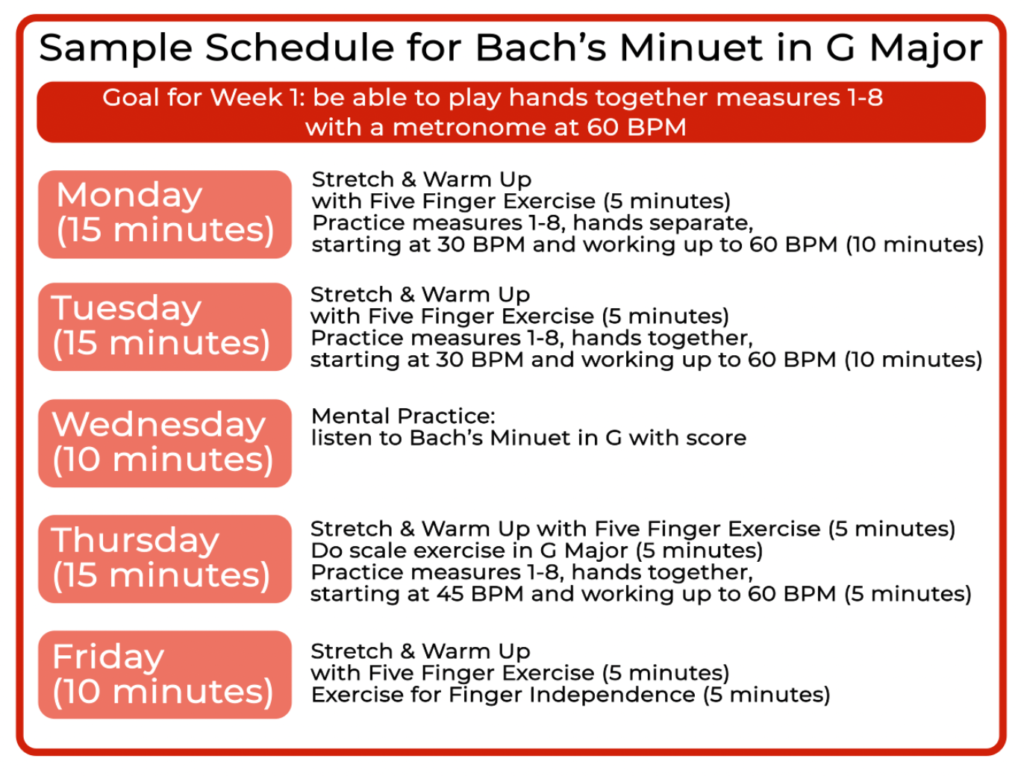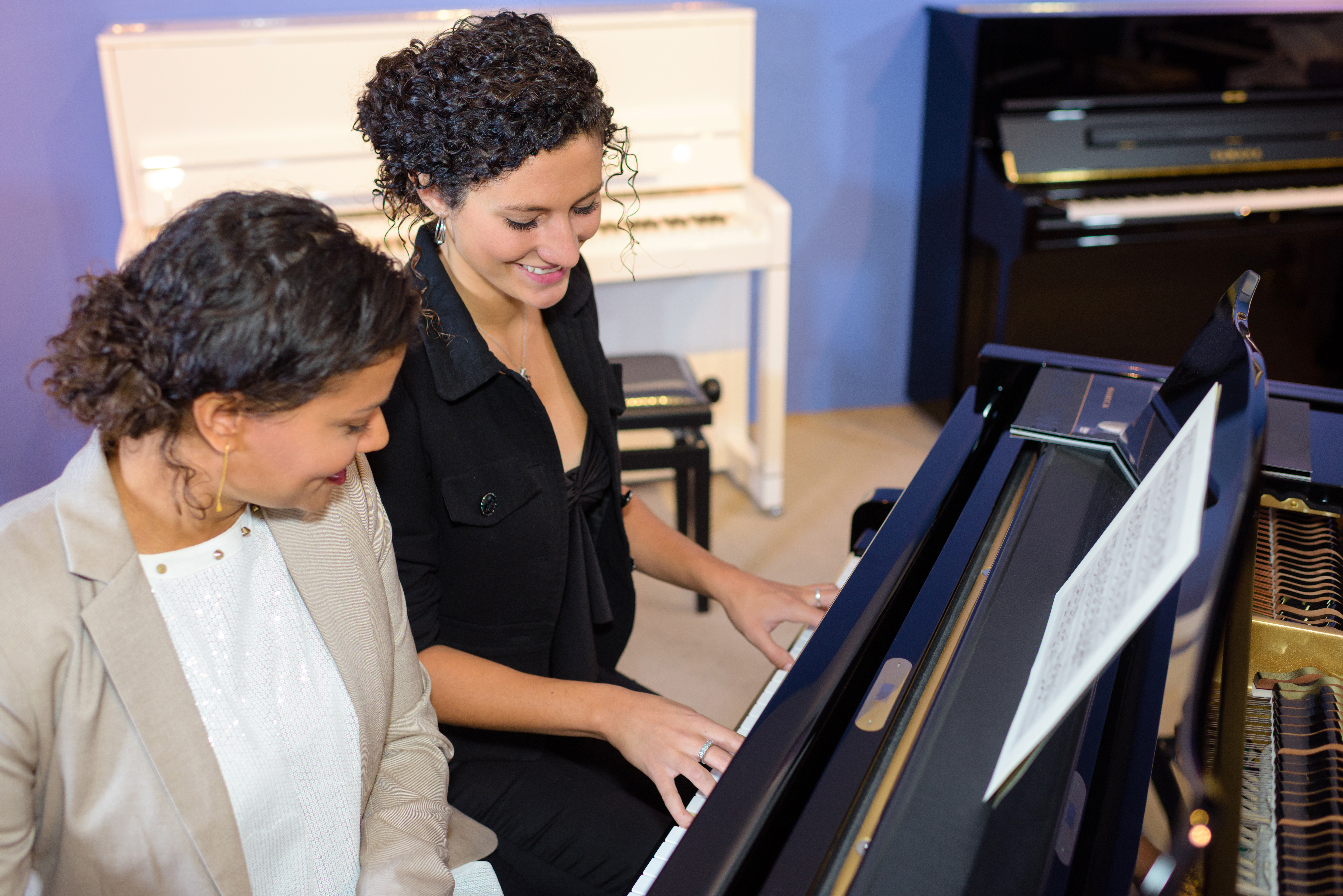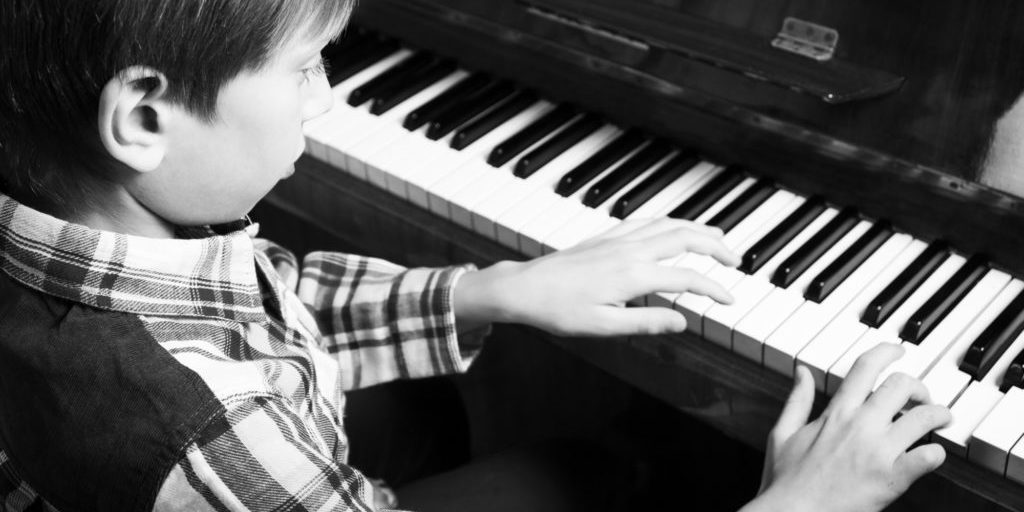Learning piano is a rewarding challenge, but where do you begin?
And how do you practice? And why?
This article provides a comprehensive practice guide to answer these questions and help you get started on the right track. The eight tips discussed here will help you effectively improve your piano skills.
Tip 1: Mental Practice
Why? Learning a piece of music away from the piano can drastically improve the efficiency of your practice sessions. Studying away from the piano, or mental practice, will help you keep a clear goal in mind when you practice and you will more likely avoid establishing bad habits. You will be able to achieve your goals quicker if you implement mental practice early on!
How? Here are some of the basic ways to practice mentally.
- Research the piece that you are learning. Who is the composer? When was it written? Read our articles on the style periods (Baroque, Classical, Romantic, Modern, or Postmodern/Contemporary)!
- Listen to several pieces written by the composer AND his/her contemporaries. This will allow you to get a better understanding of the style, touch, and character of the piece you are learning. Don’t just listen to solo piano pieces, but also listen to pieces for other instruments, orchestra, and some opera! Listening to music performed by the best performer(s) will help you to develop a good ear, motivate you to become a better player, and inspire you to be creative at your interpretive choices. You can also compare the same piece performed by different performers. Did you prefer one to the other? Can you tell the difference between the performances? Through the listening process, you can develop your taste - you can find your favorite pianists, composers, and ensembles.
- Study the score. What is the character of the piece you are learning? Is it calm? Playful? Dramatic? Melancholic? Does this piece grow louder? Softer? Is the texture thin or dense? When you have a clear idea of what the kinds of sounds the piece should have, visualize yourself playing it as you read through the score.
Tip 2: Take Care of Your Body
Why? Piano playing is a physical activity, so you should warm up, stretch, take breaks when you feel tired, and drink plenty of water. Using these tips will help you avoid pain in your practice sessions.
How? Our piano instructor, Michelle Huang has a great video on warm-up exercises for pianists! Additionally, always have water available during the practice session.
Tip 3: Practice Technique
Why? Practicing technique is not as exciting as learning a new piece, but technique will help you immensely on your piano playing journey. By using wrist, finger, and scale practice, you will be able to overcome technical challenges in the music you want to play and help you reduce tension as you play.
How? Our piano teachers cover a lot of helpful techniques on our YouTube channel, below are a few to begin. Choose one or two techniques to practice during each session to focus on building up your skills!
1. Basic Five Finger Exercise. This is a great set of exercises to build finger strength and independence. As you get more comfortable with this exercise, try playing the five finger exercise in all the different major and minor keys.
2. Exercise for Flexible Wrist. After you begin to build up some of your finger independence, try the flexible wrist version of the five finger exercise. Keeping your wrist flexible will help you avoid tension and give you rich tones.
3. Exercise for Arm Weight. The quality of sound you make is directly related to how you use your arms. When you are working on this exercise, your arm should feel completely loose. It should feel like you are hanging onto the key because of the firm finger tip. If someone pokes your arm, it should wiggle without any resistance.
4. Exercise for Finger Independence. This exercise will help you with your finger control and how to produce tones evenly. Playing with an even sound quality is especially important when you are playing fast passages. The exercise presented here focuses on making the 4th and 5th fingers more independent.
5. Scales and Arpeggios. Scales and arpeggios are integral to so much piano music, so focusing separately on them will greatly benefit you in the long run. As you practice your scales and arpeggios, make sure to keep a flexible wrist and pay attention to your arm weight!
Tip 4: “Chunk” Your Practice
Why? Piano playing involves understanding and executing many different pieces of information at the same time. This can be particularly overwhelming for the beginning pianist, there are so many keys and so many different things for your hands to be doing! Instead of trying to master everything at once, break down your piece into small chunks, or even by hand. This will reduce the information you are tackling at one time.
How? A great example of chunking is to break down the music you are working on into sections of two, four, or eight measures; then focus on learning only one of these sections at a time. Try learning just the right hand of the small section, then the left hand, and finally, try putting both hands together. Chunking is also helpful when practicing difficult passages and techniques. Choose one of these passages or techniques, and focus on just that one aspect to help build your muscle memory and accelerate the learning process. One example of this type of chunking is if there are a lot of large jumps in one hand, practice only the hand position shifts. Once you are comfortable with those, gradually add in other elements of the music.
Tip 5: Practice Slowly
Why? Slow muscular motion will train your brain and muscle memory. You will get to the faster tempo sooner if you can teach your muscles to play slowly and with precision. Practicing slowly will be also helpful if you are working on memorization and focusing on your technique.
How? Play the section at slower than half tempo. Use a metronome to ensure that you maintain the same speed and do not slow down or speed up while playing. While practicing, also count the beat subdivisions out loud (one - and, two - and, or one-e-and-a, two-e-and-a). Once you master the section at a slow tempo, gradually increase the speed on your metronome. Increments of two beats per minute (BPM) are considered small enough change so that our body does not tense up.
Tip 6: Stay Focused
Why? To be successful in a performance situation, you need to be able to stay focused, so practice staying focused in your practice sessions. When your mind wanders while practicing, you let your muscles develop bad habits that are difficult to unlearn. Staying focused and not randomly playing through passages will make your practice sessions more efficient.
How? Pay attention to what you are playing and how it sounds. Try playing through a short phrase and see if you can play it without any mistakes. If you make a mistake, stand up and walk around to ‘reset’ your hands and mind. Then come back to the piano and play the same phrase. If you make the mistake again, go back to chunking and practicing the section slowly to avoid ingraining the habit of playing the wrong notes or rhythms.
Tip 7: Record yourself
Why? Because of the amount of material you are coordinating to practice piano, it is easy to not notice mistakes in the moment. For example, you may be playing a rhythm incorrectly or using bad posture. It can be easier to catch such issues when you review a recording of your practice session. You can then address these problems in your next practice sessions. Make sure to check-in with your progress by recording yourself.
How? Use your phone to make a video of yourself playing piano. Watch and listen to it to evaluate how you are doing. If you see or hear something that is not right, mark it on your score and think of how you can do it differently next time. For example, if you noticed that there was too long of a pause when shifting the hand positions, then in your next sessions, practice only the hand shifts. If you realize that there is a note that you always play wrong, then you can ask yourself the following questions: Am I using a good fingering? Am I familiar enough with the notes? Try saying the finger numbers out loud or sing the melody as you play. Furthermore, by making a video, you can check your posture for issues. Do your shoulders look tense? Is your back hunched? Are you clenching your jaw? If you notice any of these habits, focus on fixing them in your following practice sessions.
Tip 8: Create a Practice Schedule
Why? Scheduling and planning practice sessions allows you to take control of your progress. You can set goals of what you want to work on and what you want to achieve and when. Remember that even short practice sessions are useful, you will make better progress by practicing fifteen minutes a day, five days a week, than if you only practice once a week for two hours straight.
How? A great way to create a practice schedule is to use the SMART goals. Having a specific goal in mind and the steps you will take to reach it will make your piano journey more successful. The goals you set for your practice session need to be measurable--can you tell if you made progress or not? Create goals for your weekly practice sessions that are achievable. This aligns with the measurable as well as our “chunking” idea from above. Set small goals for yourself that you can meet. If you set unachievable goals for yourself, you will become disappointed and lose your motivation. Plan to practice techniques and sections during the week that will move you towards your weekly goal. This makes what you are practicing relevant to your overall goal and ensures efficiency. When you plan your weekly practice, plan for what you will practice, when, and for how long. If you don’t have time bound goals, you won’t be able to measure your progress or see if your goals are achievable or relevant. Schedule in breaks and mental practice time as well. Remember that you can adjust your schedule weekly and that consistent practice is best. Our sample practice schedule uses SMART goals and short, consistent practice sessions.

This sample practice schedule has goals that are specific, down to the measure numbers, metronome markings, and how long the practice sessions should be, which also makes it time bound. The goals set out here are measurable, were you able to play those measures at the goal metronome marking? If so, great job! If not, set smaller, more achievable goals. The daily tasks are designed to help achieve the overall weekly goal, making the activities relevant.
Conclusion
The strategies discussed here will help you on your journey to piano mastery. Remember that it is completely normal to feel frustrated while learning a new piece, piano playing is a difficult task that takes time. Give yourself time and be patient. When you are tired, please rest. The quality of the practice session is more important than its quantity (how long you practiced each day). If you find yourself struggling, come back and review these tips and remember to relax, enjoy, and trust yourself.
Improve your piano playing with our newsletter
Useful guides and tips for pianists, all delivered straight to your inbox!
About Liberty Park Music
We are an online music school offering courses for piano, guitar, drum kit, and music theory. Our lessons are designed and taught by accredited teachers and experienced musicians from around the world. Check out our course offering here and start exploring with our 30-day free trial.







My daughter is really interested in learning how to play the piano and now that we recently moved to Bellingham, WA, we need to find a teacher for her here. We love how you talked about setting an attainable weekly goal along with daily goals to help you get that goal. We will keep these tips in mind as we search for a professional offering piano lessons in our new area.
thank you for giving me wonderful information
I am so glad a friend, who is a good pianist, directed me to your website. Its practical, and useful. Domo arigato gozaimashita
Thank you so much for this excellent and useful info!